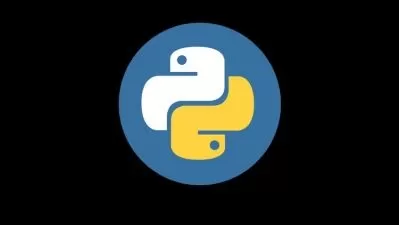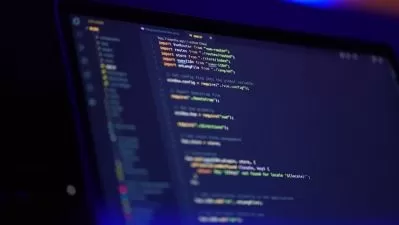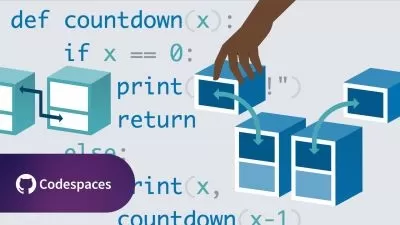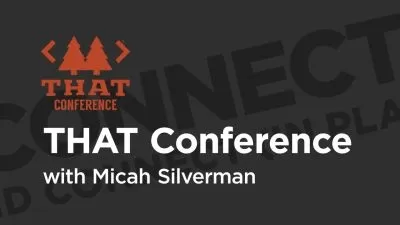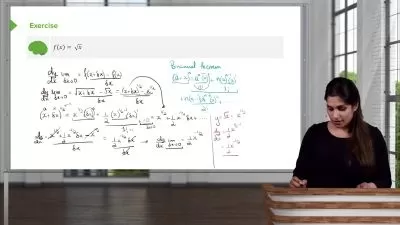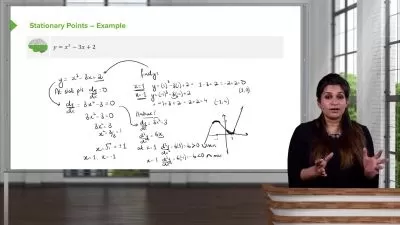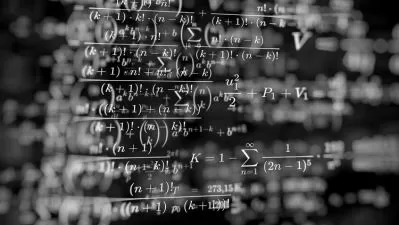Math for Programmers video edition
Focused View
17:43:31
31 View
1 - Chapter 1. Learning math with code.mp4
08:37
2 - Chapter 1. Finding a good deal.mp4
10:23
3 - Chapter 1. Modeling the physical world.mp4
05:19
4 - Chapter 1. How not to learn math.mp4
07:41
5 - Chapter 1. Using your well-trained left brain.mp4
12:49
6 - Part 1. Vectors and graphics.mp4
04:01
7 - Chapter 2. Drawing with 2D vectors.mp4
08:17
8 - Chapter 2. 2D drawing in Python.mp4
05:43
9 - Chapter 2. Plane vector arithmetic.mp4
10:51
10 - Chapter 2. Subtraction, displacement, and distance.mp4
13:43
11 - Chapter 2. Angles and trigonometry in the plane.mp4
09:42
12 - Chapter 2. From components back to angles.mp4
10:47
13 - Chapter 2. Transforming collections of vectors.mp4
10:21
14 - Chapter 3. Ascending to the 3D world.mp4
10:51
15 - Chapter 3. Vector arithmetic in 3D.mp4
08:27
16 - Chapter 3. Computing angles and directions.mp4
06:55
17 - Chapter 3. The dot product - Measuring vector alignment.mp4
08:06
18 - Chapter 3. Measuring angles with the dot product.mp4
09:09
19 - Chapter 3. The cross product - Measuring oriented area.mp4
07:07
20 - Chapter 3. Finding the length of the cross product.mp4
09:16
21 - Chapter 3. Rendering a 3D object in 2D.mp4
10:05
22 - Chapter 4. Transforming vectors and graphics.mp4
08:50
23 - Chapter 4. Composing vector transformations.mp4
05:47
24 - Chapter 4. Rotating an object about an axis.mp4
10:01
25 - Chapter 4. Linear transformations.mp4
07:23
26 - Chapter 4. Why linear transformations.mp4
11:42
27 - Chapter 4. Exercises.mp4
10:39
28 - Chapter 5. Computing transformations with matrices.mp4
06:33
29 - Chapter 5. Multiplying a matrix with a vector.mp4
11:47
30 - Chapter 5. Implementing matrix multiplication.mp4
10:46
31 - Chapter 5. Interpreting matrices of different shapes.mp4
08:02
32 - Chapter 5. Viewing square and non-square matrices as vector functions.mp4
09:10
33 - Chapter 5. Composing linear maps.mp4
08:30
34 - Chapter 5. Translating vectors with matrices.mp4
08:04
35 - Chapter 5. Translating 3D objects in a 4D world.mp4
10:36
37 - Chapter 6. Improving the Vec2 class.mp4
05:14
38 - Chapter 6. Building a vector base class.mp4
10:18
39 - Chapter 6. Unit testing vector space classes.mp4
06:25
40 - Chapter 6. Exploring different vector spaces.mp4
07:52
41 - Chapter 6. Treating functions as vectors.mp4
07:55
42 - Chapter 6. Manipulating images with vector operations.mp4
09:07
43 - Chapter 6. Looking for smaller vector spaces.mp4
07:32
44 - Chapter 6. Spanning a bigger space.mp4
08:39
45 - Chapter 6. Finding subspaces of the vector space of functions.mp4
09:17
46 - Chapter 6. Exercises.mp4
10:02
47 - Chapter 7. Solving systems of linear equations.mp4
10:41
48 - Chapter 7. Finding intersection points of lines.mp4
11:48
49 - Chapter 7. Linear equations in matrix notation.mp4
07:33
50 - Chapter 7. Identifying unsolvable systems.mp4
08:15
51 - Chapter 7. Generalizing linear equations to higher dimensions.mp4
07:44
52 - Chapter 7. Studying hyperplanes algebraically.mp4
11:18
53 - Chapter 7. Exercises.mp4
06:42
54 - Chapter 7. Changing basis by solving linear equations.mp4
12:16
55 - Part 2. Calculus and physical simulation.mp4
05:05
56 - Chapter 8. Understanding rates of change.mp4
12:19
57 - Chapter 8. Plotting the average flow rate over time.mp4
07:27
58 - Chapter 8. Approximating instantaneous flow rates.mp4
12:19
59 - Chapter 8. Approximating the change in volume.mp4
10:13
60 - Chapter 8. Plotting the volume over time.mp4
07:54
61 - Chapter 8. Improving the approximation.mp4
08:54
62 - Chapter 9. Simulating moving objects.mp4
10:29
63 - Chapter 9. Simulating acceleration.mp4
05:30
64 - Chapter 9. Digging deeper into Eulers method.mp4
07:08
65 - Chapter 9. Running Eulers method with smaller time steps.mp4
07:04
66 - Chapter 10. Working with symbolic expressions.mp4
09:02
67 - Chapter 10. Modeling algebraic expressions.mp4
12:57
68 - Chapter 10. Putting a symbolic expression to work.mp4
11:18
69 - Chapter 10. Expanding an expression.mp4
08:04
70 - Chapter 10. Finding the derivative of a function.mp4
07:51
71 - Chapter 10. Derivatives of some special functions.mp4
08:47
72 - Chapter 10. Taking derivatives automatically.mp4
11:57
73 - Chapter 10. Integrating functions symbolically.mp4
07:30
74 - Chapter 11. Simulating force fields.mp4
07:41
75 - Chapter 11. Modeling gravitational fields.mp4
05:04
76 - Chapter 11. Adding gravity to the asteroid game.mp4
07:15
77 - Chapter 11. Introducing potential energy.mp4
06:55
78 - Chapter 11. Connecting energy and forces with the gradient.mp4
09:21
79 - Chapter 11. Finding the steepness of a graph with the gradient.mp4
11:40
80 - Chapter 12. Optimizing a physical system.mp4
06:11
81 - Chapter 12. Testing a projectile simulation.mp4
09:03
82 - Chapter 12. Calculating the optimal range.mp4
07:46
83 - Chapter 12. Solving for the maximum range.mp4
08:21
84 - Chapter 12. Enhancing our simulation.mp4
05:15
85 - Chapter 12. Solving for the range of the projectile in 3D.mp4
08:29
86 - Chapter 12. Optimizing range using gradient ascent.mp4
08:14
87 - Chapter 12. Implementing gradient ascent.mp4
08:24
88 - Chapter 13. Analyzing sound waves with a Fourier series.mp4
06:16
89 - Chapter 13. Playing sound waves in Python.mp4
11:02
90 - Chapter 13. Turning a sinusoidal wave into a sound.mp4
10:40
91 - Chapter 13. Combining sound waves to make new ones.mp4
05:18
92 - Chapter 13. Building a linear combination of sinusoids.mp4
06:55
93 - Chapter 13. Decomposing a sound wave into its Fourier series.mp4
06:02
94 - Chapter 13. Defining an inner product for periodic functions.mp4
09:04
95 - Chapter 13. Fourier coefficients for other waveforms.mp4
08:06
96 - Part 3. Machine learning applications.mp4
04:23
97 - Chapter 14. Fitting functions to data.mp4
07:32
98 - Chapter 14. Measuring the quality of fit for a function.mp4
08:11
99 - Chapter 14. Calculating cost for car price functions.mp4
05:18
100 - Chapter 14. Exploring spaces of functions.mp4
07:53
101 - Chapter 14. Finding the line of best fit using gradient descent.mp4
07:38
102 - Chapter 14. Fitting a nonlinear function.mp4
11:03
103 - Chapter 15. Classifying data with logistic regression.mp4
05:56
104 - Chapter 15. Testing a classification function on real data.mp4
06:31
105 - Chapter 15. Picturing a decision boundary.mp4
07:10
106 - Chapter 15. Framing classification as a regression problem.mp4
07:37
107 - Chapter 15. Introducing the sigmoid function.mp4
06:28
108 - Chapter 15. Exploring possible logistic functions.mp4
05:46
109 - Chapter 15. Measuring the quality of fit for a logistic function.mp4
10:02
110 - Chapter 15. Finding the best logistic function.mp4
05:53
111 - Chapter 15. Testing and understanding the best logistic classifier.mp4
08:41
112 - Chapter 16. Training neural networks.mp4
08:33
113 - Chapter 16. Classifying images of handwritten digits.mp4
09:19
114 - Chapter 16. Designing a neural network.mp4
09:14
115 - Chapter 16. Calculating activations.mp4
09:38
116 - Chapter 16. Building a neural network in Python.mp4
09:10
117 - Chapter 16. Training a neural network using gradient descent.mp4
07:15
118 - Chapter 16. Automatic training with scikit-learn.mp4
05:38
119 - Chapter 16. Calculating gradients with backpropagation.mp4
12:08
120 - Appendix B. Python tips and tricks.mp4
07:27
121 - Appendix B. Collections of data in Python.mp4
09:37
122 - Appendix B. Generators.mp4
09:21
123 - Appendix B. Working with functions.mp4
11:24
124 - Appendix B. Plotting data with Matplotlib.mp4
06:47
125 - Appendix B. Object-oriented programming in Python.mp4
06:09
126 - Appendix B. Operator overloading.mp4
06:21
More details
User Reviews
Rating
average 0
Focused display

O'Reilly
View courses O'ReillyO'Reilly Media is an American learning company established by Tim O'Reilly that publishes books, produces tech conferences, and provides an online learning platform. Its distinctive brand features a woodcut of an animal on many of its book covers.
- language english
- Training sessions 125
- duration 17:43:31
- Release Date 2023/11/06









